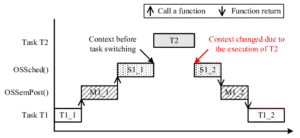Context Switching
In a multitasking operating system, multiple processes may be active at the same time, but only one process can use the CPU at any given moment. The operating system switches between these processes rapidly to give the illusion of parallel execution. This switch from one process to another is called context switching.
It is a core mechanism that enables modern operating systems to handle multiple applications, background tasks, and system services simultaneously.
What is Context Switching?
Context switching is the process where the operating system saves the state (or context) of a currently running process and loads the state of the next process to be executed.
This context includes:
- Values in CPU registers
- Program counter (next instruction)
- Process-specific data stored in memory
- Memory management information
- Other critical info stored in the Process Control Block (PCB)
When switching back to a process later, the OS restores all this information so that the process resumes exactly where it left off.
When Does Context Switching Happen?
Context switching occurs during the following events:
- Multitasking: CPU shifts between multiple running processes.
- Interrupts: When a hardware or software interrupt is raised.
- I/O Operations: The current process waits for I/O; CPU switches to another.
- System Calls: When the process needs kernel-level services.
- Preemptive Scheduling: Time slice expires or a higher-priority task needs the CPU.
Steps Involved in Context Switching
- Save current process state: The OS saves all necessary info of the currently running process in its PCB.
- Update process status: The state of the process is updated (e.g., from Running to Ready or Waiting).
- Select next process: The scheduler picks the next process from the ready queue.
- Load new process state: The OS restores the state of the new process from its PCB.
- Transfer control: The CPU begins executing the new process.
Is Context Switching Expensive?
Yes, context switching comes with an overhead:
- Time is spent saving/restoring states instead of executing actual processes.
- Frequent switching may lead to reduced performance (especially if processes are short-lived).
However, this trade-off is essential for achieving responsiveness, fairness, and multitasking.
Real-World Example
Imagine you’re working on a document, and an email notification pops up. You temporarily pause your work, check the email, then return to your document exactly where you stopped. That’s context switching—your brain (CPU) switched tasks while remembering where to resume.
Summary
Context switching is fundamental to how operating systems manage multiple processes efficiently. It allows the CPU to pause and resume different processes without loss of data, ensuring smooth multitasking, better resource utilization, and a responsive computing experience.
